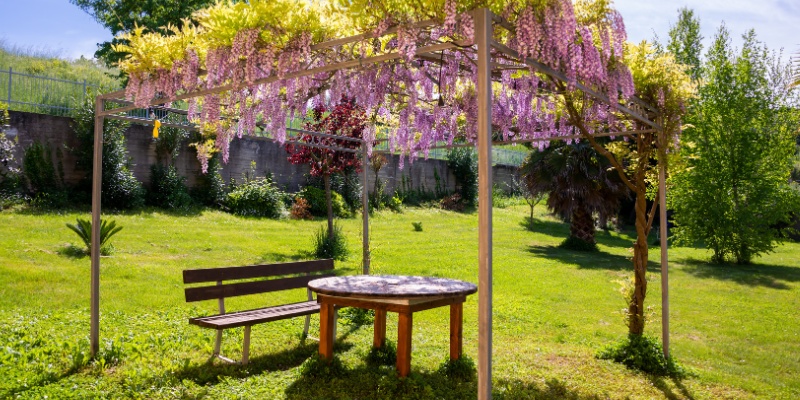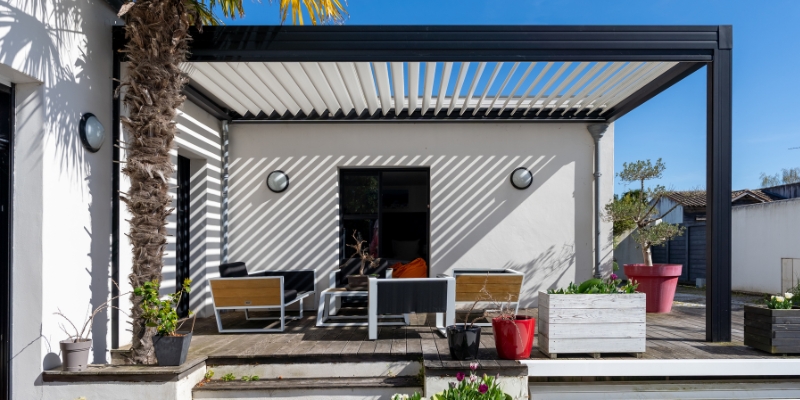
Whether you’re a seasoned gardener or a new enthusiast, understanding how to effectively plant, train and maintain wisteria on your pergola is beneficial, right?
Wisteria offers a unique blend of aesthetic appeal and practical benefits. In this article, we’re diving into everything you need to know about growing wisteria on a pergola.
What is Wisteria?
For those who don’t know, Wisteria is a group of twining plants known for their flowers. It is a popular choice for gardeners looking to enhance their outdoor structures, like pergolas or gazebos.
The wisteria plant is a vigorous grower, often covering entire pergolas with lush foliage and fragrant blooms in early spring and early summer.
It can easily grow on a pergola as it can easily support climbing plants like the vigorous wisteria vine.
Choice of Diverse Species
When it comes to choosing wisteria for your pergola, the two most prominent species are Chinese wisteria (Wisteria sinensis) and Japanese wisteria (Wisteria floribunda).
- Chinese wisteria is known for its prolific flowering and ability to bloom before its foliage emerges.
- Japanese wisteria, on the other hand, is celebrated for its longer, more fragrant blooms that offer attractive color and scent.
Both species are excellent choices for adding beauty and providing shade to pergolas as one of the main purposes of these structures.
Benefits of Growing Wisteria on a Pergola

1. Enhancing Garden Beauty with Aesthetic Appeal
The addition of wisteria vines to a pergola transforms an ordinary garden into a stunning outdoor space. The cascading wisteria flowers range from deep purples and violets to soft whites.
As the wisteria plant matures, it covers the pergola in a vibrant blend of color and texture.
This visual transformation not only adds to the overall appeal of your outdoor space but also increases the value of your property.
2. Creating Natural Shade and Cooling Effects
One of the practical benefits of training wisteria on a pergola is the creation of a natural canopy that provides shade.
During the warmer months, the dense foliage and blooms of the wisteria vine offer a cool, shaded retreat in your garden.
This natural cooling effect can make outdoor spaces more comfortable and enjoyable, especially in the heat of early summer.
3. Fragrance and Attracting Wildlife
The fragrant blooms of wisteria play a crucial role in attracting wildlife to your garden.
The sweet scent of wisteria flowers, particularly noticeable in late spring and early summer, is irresistible to pollinators like bees and butterflies.
By planting wisteria, you contribute to the local ecosystem, supporting biodiversity. The presence of these pollinators not only aids in the health of your garden but also ensures the continued blooming of your wisteria.
Pre-Planting Considerations for Wisteria
1. Assessing Space Requirements for Wisteria Growth
Before planting wisteria, it’s crucial to understand its space needs. Wisteria vines are known for being vigorous climbers, capable of reaching extensive lengths.
When planning to train wisteria on a pergola, ensure there is enough space for the vine to grow both vertically and horizontally.
This consideration is vital not only for the aesthetic aspect but also for the plant’s health. Adequate space allows for proper air circulation and sunlight exposure, which are essential for the plant’s growth.
2. Pergola Strength: A Key Factor for Supporting Wisteria
Given the weight and vigorous growth of wisteria vines, the strength and durability of your pergola are crucial. It’s important to buy or build a pergola that can withstand the weight of a mature wisteria plant.
Materials like reinforced wood or extruded aluminum pergolas are recommended. It’s also important to consider your pergola’s long-term maintenance, as the wisteria’s weight will increase over time.
Ensuring your pergola is built with strong materials and proper support will guarantee that it remains a beautiful and safe structure in your garden for years to come.
3. Climate and Weather Conditions for Growing Wisteria
Growing wisteria successfully requires an understanding of the ideal climate and weather conditions for these beautiful vines. Wisteria is a hardy plant, but it thrives best in certain environments.
Wisteria plants are best suited to temperate climates. They can withstand a range of temperatures, but they flourish in areas where winters are not excessively harsh and summers are moderately warm.
Chinese and Japanese wisteria can survive in a temperature range between 5 to 32 ℃ (89.6∘F –41∘F). But the conditions can vary for the other varieties.
However, extreme cold can damage the flower buds, leading to less flowering in the spring.
The right soil and sunlight conditions are paramount for a healthy wisteria plant. Wisteria thrives in well-draining soil, as waterlogged conditions can lead to root rot.
The ideal soil should be fertile and slightly acidic to neutralize pH. As for sunlight, wisteria requires full exposure to the sun to bloom fully.
A minimum of six hours of direct sunlight is recommended. Planting your wisteria in a spot that receives lots of sunlight ensures vibrant flowering and healthy growth.
While wisteria requires regular watering, especially in the first few years after planting, it does not do well in overly wet conditions. Areas with well-distributed rainfall throughout the year are ideal.
However, in regions with heavy and frequent rains, ensuring good drainage is essential to prevent root rot. Wisteria can tolerate a range of humidity levels, but in very humid climates, it’s important to ensure good air circulation around the plant to reduce the risk of fungal diseases.
If you live in an area with less than ideal conditions for wisteria, don’t worry. With proper care, wisteria can adapt to a variety of environments.
In colder regions, choose a sheltered spot for your wisteria to protect it from harsh winter winds. In areas with less sunlight, consider pruning nearby trees to increase sun exposure.
Techniques for Training Wisteria to Climb a Pergola

Training wisteria to climb a pergola or any other outdoor structure is essential for achieving the desired aesthetic and ensuring the health of the plant.
- Initial Training: After planting, guide the young shoots of your wisteria towards the pergola. Use soft garden ties to attach the shoots to the pergola gently.
- Encouraging Vertical Growth: As the wisteria grows, continue to tie new growth to the pergola, focusing on vertical training in the early stages. This encourages the plant to cover the structure evenly.
- Horizontal Training for Fuller Coverage: Once your wisteria reaches the top of the pergola, start training it to grow horizontally along the beams. This will create a fuller, more lush appearance.
Ongoing Care and Maintenance of Wisteria
Pruning: Essential for Healthy Growth and Blooms
Pruning is a critical aspect of wisteria care.
Here’s what you need to know about it:
- Best Times to Prune: The best time to prune wisteria is twice a year – once in late winter, before the plant breaks dormancy, and again in late summer, after the blooms have faded.Late winter pruning involves cutting back the previous year’s growth to a few buds. This supports the development of short branches that produce flowers. Late summer pruning helps control the size of the plant and prevents it from becoming too heavy for the pergola.
- Pruning Techniques: When pruning, focus on removing any dead or diseased wood and thinning out crowded areas to improve air circulation. Cut back side shoots to about 6 inches from the main branch, and remove any suckers growing from the base of the plant.
Watering and Fertilization: Balancing for Optimal Growth
- Watering Needs: Wisteria requires consistent moisture, especially during its growing season in spring and summer. Water deeply once a week, allowing the soil to dry out slightly between waterings. Avoid overwatering, as wisteria does not tolerate waterlogged soil.
- Fertilization Requirements: Fertilize wisteria in early spring with a balanced, slow-release fertilizer to support vigorous growth and flowering. Avoid high-nitrogen fertilizers, as they can encourage leaf growth at the expense of flowers.
Managing Pests and Diseases
Wisteria is relatively hardy but can occasionally face issues with pests and diseases.
- Pests: Common pests include aphids and Japanese beetles. These can be managed with insecticidal soap or neem oil, applied as needed.
- Diseases: Wisteria can be affected by fungal diseases like powdery mildew or root rot. To prevent these issues, ensure good air circulation and avoid overwatering.
Selecting the Ideal Pergola for Your Wisteria
First of all, when planting wisteria, choosing the right type of pergola is crucial. The structure needs to be robust enough to support the weight of mature vines, which can become quite heavy.
- Wooden pergolas, with their natural aesthetic, are a popular choice but require regular pruning and maintenance to manage the vigorous growth of wisteria.
- Aluminum pergolas offer greater strength and durability, making them suitable for supporting the weight of both Chinese wisteria and Japanese wisteria, as well as other wisteria species. Nowadays more and more people replace their wooden pergolas with aluminum ones (one of the most trusted brands in the pergolas world is Hanso Home).
Summary
In summary, wisteria vines offer both functional and aesthetic advantages when grown on pergolas. The visual appeal of wisteria, with its vibrant flowers and lush foliage, significantly enhances the look of any backyard or garden.
These plants not only add a splash of color but also provide practical benefits like providing shade and making outdoor spaces more comfortable during warmer months.
The journey of cultivating wisteria on a pergola involves careful planning and consistent care. Whether you choose Japanese wisteria, Chinese wisteria, or another variety, understanding the specific needs for planting, training, and maintaining them is key to success.
Regular tasks such as pruning, watering, and managing pests and diseases are essential to keep your wisteria healthy and flourishing.
Remember, growing wisteria requires a commitment to ongoing care. With the right approach and a bit of patience, your pergola can become a standout feature in your garden, showcasing the natural beauty and versatility of wisteria.


